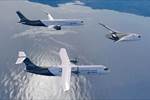Airbus A321XLR with Pratt & Whitney engine receives EASA type certification
GTF-powered A321XLR to introduces capacity and new route flexibility, clearing the way for its entry into commercial service.
Source | Airbus
The European Union Aviation Safety Agency (EASA) has issued type certificate for the (Toulouse, France) A321XLR powered by Pratt & Whitney (East Hartford, Conn., U.S) GTF engines. This follows the certification of the CFM LEAP-1A powered A321XLR in July 2024 — featuring composites in its fan blades and low-pressure turbine rings and blades — and paves the way for the first customer aircraft with Pratt & Whitney engines to enter into service later in 2025.
“The A321XLR already displays its versatility crossing the Atlantic in daily operations. With the certification and entry-into-service of the GTF-powered A321XLR we will see more operators introduce this aircraft,” says Christian Scherer, CEO commercial aircraft at Airbus. “It is also good news for our customers’ passengers who will benefit from the convenience of new direct city-to-city connections with a heightened level of cabin comfort.”
The A321XLR sits side by side with widebodies in an airline’s fleet. It introduces the flexibility to add capacity, to open new routes, or even to continue operating existing ones when demand is variable. This is all while burning 30% less fuel per seat than previous generation competitor aircraft. The A321XLR’s new Airspace cabin will provide passengers long haul comfort in all classes. All of these improvements and innovations, of course, are .
The first A321XLR completed its maiden flight in June 2022. This was followed by an extensive test program involving three test aircraft. In 2024, the A321XLR entered into service. So far more than 500 Airbus A321XLRs have been ordered.
Related Content
-
The potential for thermoplastic composite nacelles
Collins Aerospace draws on global team, decades of experience to demonstrate large, curved AFP and welded structures for the next generation of aircraft.
-
Infinite Composites: Type V tanks for space, hydrogen, automotive and more
After a decade of proving its linerless, weight-saving composite tanks with NASA and more than 30 aerospace companies, this CryoSphere pioneer is scaling for growth in commercial space and sustainable transportation on Earth.
-
Automated robotic NDT enhances capabilities for composites
Kineco Kaman Composites India uses a bespoke Fill Accubot ultrasonic testing system to boost inspection efficiency and productivity.



